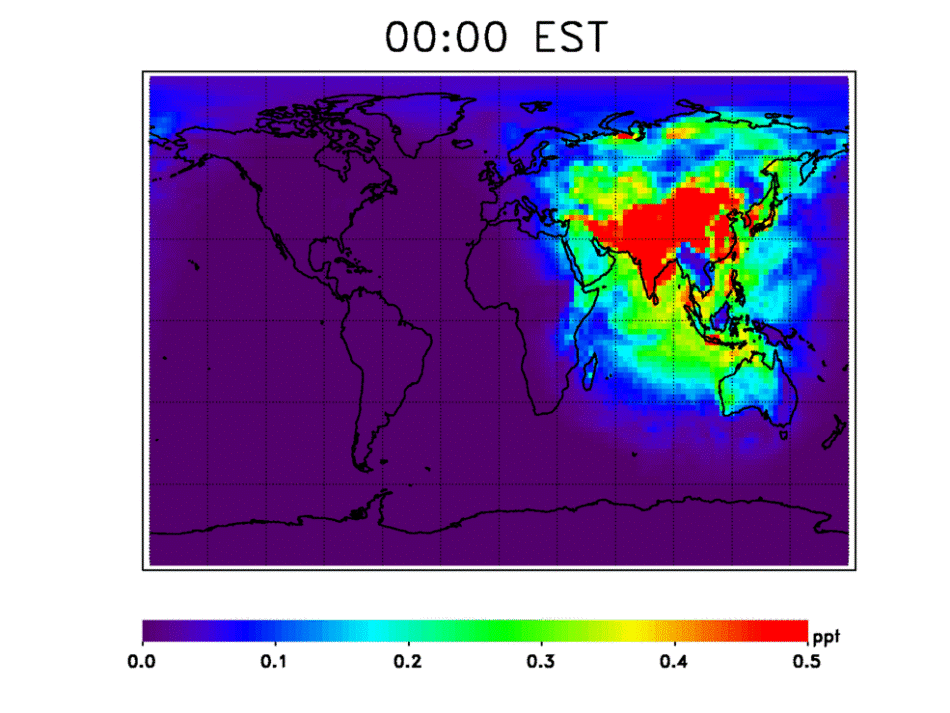Dec 3 2018
According to new NASA study, a basic molecule in the atmosphere that serves as a “detergent” to break down methane and other greenhouse gases has been discovered to recycle itself to maintain a balanced global presence in the face of increasing emissions. Understanding its role in the atmosphere is crucial for establishing the lifetime of methane, a strong contributor to climate change.
 Model output of OH primary production over a 24-hour period in July tracks with sunlight across the globe. Higher levels of OH over populated land are likely from OH recycling in the presence of NO and NO2, which are common pollutants from cars and industry. (Credits: NASA/Julie Nicely)
Model output of OH primary production over a 24-hour period in July tracks with sunlight across the globe. Higher levels of OH over populated land are likely from OH recycling in the presence of NO and NO2, which are common pollutants from cars and industry. (Credits: NASA/Julie Nicely)
The hydroxyl (OH) radical, a molecule composed of one hydrogen atom, one oxygen atom with a free (or unpaired) electron is one of the most reactive gases in the atmosphere and repeatedly breaks down other gases, effectively terminating their lifetimes. In this manner, OH is the chief check on the concentration of methane, a powerful greenhouse gas that is second only to carbon dioxide in adding to rising global temperatures.
With the increase of methane emissions into the atmosphere, researchers historically thought that might cause the amount of hydroxyl radicals to be depleted on the global scale and, consequently, extend methane’s lifetime, presently estimated to be nine years. However, besides looking globally at main sources of OH and the amount of methane and other gases it breaks down, this new study takes into consideration secondary OH sources, recycling which occurs after OH breaks down methane and reforms in the presence of other gases, which has been seen on regional scales before.
“OH concentrations are pretty stable over time,” said atmospheric chemist and lead author Julie Nicely at NASA’s Goddard Space Flight Center in Greenbelt, Maryland. “When OH reacts with methane it doesn't necessarily go away in the presence of other gases, especially nitrogen oxides (NO and NO2). The break down products of its reaction with methane react with NO or NO2 to reform OH. So OH can recycle back into the atmosphere.”
Nitrogen oxides are one set of several gases that add to recycling OH back into the atmosphere, according to Nicely’s study, reported in the Journal of Geophysical Research: Atmospheres. She and her colleagues used a computer model informed by satellite observations of numerous gases from 1980 to 2015 to mimic the likely sources for OH in the atmosphere. These include reactions with the above-mentioned nitrogen oxides, ozone, and water vapor. They also examined a rare potential source of new OH: the enlargement of the tropical regions on Earth.
OH in the atmosphere also develops when UV sunlight reaches the lower atmosphere and reacts with water vapor (H2O) and ozone (O3) to form two OH molecules. Over the tropics, UV sunlight and water vapor are abundant. The tropics, which spread the region of Earth to either side of the equator, have displayed some indication of widening farther north and south of their present range, possibly because of rising temperatures impacting air circulation patterns. This means that the tropical region primed for producing OH will potentially increase over time, resulting in a higher amount of OH in the atmosphere. This tropical widening process is slow, however, expanding only 0.5 to 1° in latitude every 10 years. But the small effect may still be vital, according to Nicely.
She and her team learned that, separately, the tropical widening effect and OH recycling through reactions with other gases each comprise a comparatively small source of OH, but combined they basically replace the OH used up in the breaking down of methane.
“The absence of a trend in global OH is surprising,” said atmospheric chemist Tom Hanisco at Goddard who was not involved in the study. “Most models predict a ‘feedback effect’ between OH and methane. In the reaction of OH with methane, OH is also removed. The increase in NO2 and other sources of OH, such as ozone, cancel out this expected effect.” But since this research examines the past thirty-five years, it is not certain that as the atmosphere continues to change with global climate change that OH levels will continue to recycle in the same manner into the future, he said.
In the long run, Nicely sees the results as a way to tweak and update the assumptions that are made by scientists and climate modelers who define and predict how OH and methane interact throughout the atmosphere.
This could add clarification on the question of will methane concentrations continue rising in the future? Or will they level off, or perhaps even decrease? This is a major question regarding future climate that we really don't know the answer to.
Julie Nicely, Atmospheric Chemist and Lead Author, NASA’s Goddard Space Flight Center.
The research used data from NASA’s Total Ozone Mapping Spectrometer instrument, the Ozone Monitoring Instrument aboard NASA’s Aura satellite, the Atmospheric Infrared Sounder aboard NASA’s Aqua satellite, the National Oceanic and Atmospheric Administration Cooperative Global Air Sampling Network, the Modern-Era Retrospective analysis for Research and Applications, Version 2 data set and the Global Model Initiative chemical transport model.